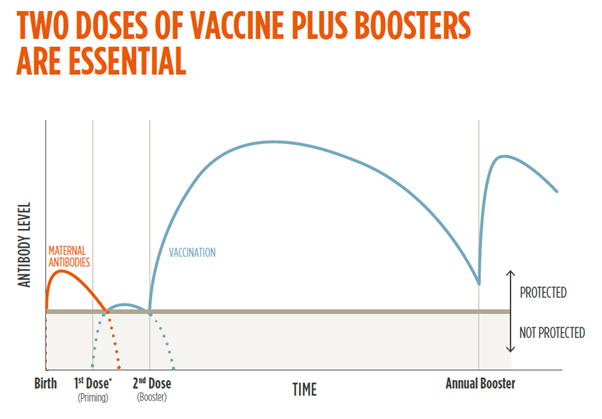Stock Journal Technical Column May 2023
Author: Mary Rowe, Zoetis
The basis of any vaccination program is to provide long lasting protection prior to exposure to a disease. Disease challenges can happen throughout the life of an animal. Vaccines rely on the animals own immune system to provide that protection. They do this by stimulating the immune system to produce an antibody response to a specific “foreign invader” such as a bacteria, virus or protein.
Most livestock vaccines on the market in Australia stimulate the immune system by introducing a killed or inactivated version of the “foreign invader” to the animal’s immune system. The animals immune system then swings into action and produces protective cells and proteins – including antibodies – that target the specific “foreign invader”. By using a killed or inactivated version of the foreign invader, vaccines produce a strong immunity to that disease without the animal actually contracting the disease and suffering associated production losses.
To provide long-term protection, most vaccines require two shots. The first shot, or priming dose, stimulates the immune system to recognise the particular bacteria, virus or protein contained in the vaccine. As a result, the animal’s immune system produces antibodies and memory cells against that specific “invader”. This first dose does not give sustained protection^. When you give the second dose, the memory cells produced in response to the first vaccination swing into action, producing antibodies on a far greater scale and in a short period of time. The response to the second vaccination gives the animal protection for up to 12 months*.
To maintain a protective level of antibodies in the animal year on year, annual boosters are essential. The annual booster shot has a similar effect on the immune system as the ‘second dose’, that is, massive amounts of antibodies are produced by the immune system, giving long-term protection. These annual booster shots are only effective if the animal has received its two primary doses of vaccine^.
WHY VACCINATE PRE-LAMBING?
When annual boosters are administered to the ewe pre-lambing, the benefits are two-fold. First, the dam is continually protected from the effects of the disease(s) you are vaccinating against. Secondly, antibodies are passed to the lamb in the colostrum, or “first milk”, to provide protection from these diseases to the new-born offspring in the first weeks of life.
Lambs are born without existing immunity to disease. The only protection against disease that they have in the first weeks of life is the “passive” immunity that is provided by the ewe in her colostrum.
To maximise the amount of protective antibodies in the colostrum, ewes must have adequate antibody levels themselves. This is done by vaccinating the ewe 4-6 weeks pre-lambing. Using Glanvac® and Eryvac® will provide protection from the 5 fatal clostridial diseases – pulpy kidney, black leg, blacks disease, tetanus and malignant oedema – as well as the production-limiting diseases Cheesy gland and Erysipelas arthritis.
The passive protection provided to the lamb in the colostrum lasts for about 10 weeks* during which time a vaccination program can be started in the lamb. A booster shot pre-lamb will provide the protection the new-born lamb needs to survive and thrive.
* Refer to product label for specific details on timing of vaccinations and duration of immunity.
^ For vaccines with a two-shot protocol. Gudair® and Scabigard® are single dose vaccines which stimulate the immune system in a different way to what is outlined here.






